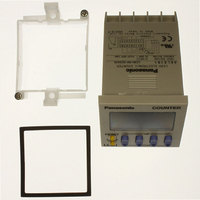LC4H-R4-DC24VS Panasonic Electric Works, LC4H-R4-DC24VS Datasheet - Page 27

LC4H-R4-DC24VS
Manufacturer Part Number
LC4H-R4-DC24VS
Description
COUNTER DIGITAL 24VDC SCREW TERM
Manufacturer
Panasonic Electric Works
Series
LC4Hr
Datasheet
1.LC4H-R4-DC24V.pdf
(45 pages)
Specifications of LC4H-R4-DC24VS
Count Rate
30Hz or 5kHz Selectable
Number Of Digits/alpha
4
Input Type
Switch Closure or Transistor Switch
Output Type
Switch Closure
Voltage - Supply
12 V ~ 24 V
Display Type
LCD Red/Yellow
Lead Free Status / RoHS Status
Lead free / RoHS Compliant
Other names
255-1221
Available stocks
Company
Part Number
Manufacturer
Quantity
Price
Company:
Part Number:
LC4H-R4-DC24VS
Manufacturer:
Panasonic Electric Works
Quantity:
135
PRECAUTIONS IN USING THE LC4H SERIES
Precautions during usage
1. Terminal wiring
1) When wiring the terminals, refer to the
terminal layout and wiring diagrams and
be sure to perform the wiring properly
without errors.
2) When using the instrument with an
flush mounting, the screw-down terminal
type is recommended. For the pin type,
use either the rear terminal block
(AT78041) or the 8P cap (AD8-RC) for
the 8-pin type, and the rear terminal
block (AT78051) or the 11P cap (AT8-
DP11) for the 11-pin type. Avoid solder-
ing directly to the round pins on the unit.
When using the instrument with a front
panel installation, use the DIN rail termi-
nal block (AT8-DF8K) for the 8-pin type
and the DIN rail terminal block (AT8-
DF11K) for the 11-pin type.
3) After turning the counter off, make
sure that any resulting induced voltage
or residual voltage is not applied to
power supply terminals W through U (8-
pin type), W through P (11-pin type) or
power supply wire is wired parallel to the
high voltage wire or power wire, an
induced voltage may be generated
between the power supply terminals.)
4) Have the power supply voltage pass
through a switch or relay so that it is
applied at one time. If the power supply
is applied gradually, the counting may
malfunction regardless of the settings,
the power supply reset may not function,
or other such unpredictable occurrence
may result.
2. Input connections (except LC4H-
S/AC type)
The power circuit has no transformer
without a transformer (power and input
terminals are not insulated). When an
input signal is fed to two or more coun-
ters at once, do not arrange the power
circuit in an independent way.
If the counter is powered on and off inde-
pendently as shown in Fig. A, the coun-
ter's internal circuitry may get dam-
aged.Be careful never to allow such cir-
cuitry. (Figs. A, B and C show the circuit-
ry for the 11-pin type.)
140
( Fig. A )
Input contact or transistor
1
and
2
(screw terminal type). (If the
3
3
2
2
Input
terminal
Input
terminal
10
10
Power
supply
( Fig. B )
Input contact
or transistor
Input contact
or transistor
If independent power circuitry must be
used, keep the input contacts or transis-
tors separate from each other, as shown
in Fig. B.
When power circuitry is not independent,
one input signal can be fed to two or
more counters at once, as shown in Fig.
C.
3. Input and output
1) Signal input type
(1) Contact point input
Use highly reliable metal plated contacts.
Since the contact point’s bounce time
leads directly to error in the count value,
use contacts with as short a bounce time
as possible. In general, select Input 1
and Input 2 to have a maximum counting
speed of 30 Hz and to be reset with a
minimum input signal width of 20 ms.
Note: The LC4H-W does not have the lock input
R,
(2) Non-contact point input
Connect with an open collector. Use
transistors whose characteristics satisfy
the criteria given below.
V
I
I
( Fig. C )
Input contact
or transistor
C
CBO
CEO
= 20 mA min.
8-pin type
11-pin type
Screw terminal type
7
.
= 6µA max.
= 20 V min.
Reset input
3
3
3
3
Input 1
2
2
2
2
Input
terminal
Input
terminal
Input
terminal
Input
terminal
Input 2
10
10
10
10
1
3
6
Lock
input
—
4
7
5
5
8
4
6
9
Power
supply
Power
supply
10
3
7
Also, use transistors with a residual volt-
age of less than 2 V when the transistor
is on.
Note: The LC4H-W does not have the lock input
R,
* The short-circuit impedance should be
less than 1 kΩ.
[When the impedance is 0 Ω, the current
coming from the input 1 and input 2 ter-
minals is approximately 12 mA, and from
the reset input and lock input terminals is
approximately 1.5 mA.]
Also, the open-circuit impedance should
be more than 100 kΩ.
* As shown in the diagram below, from a
2) The input mode and output mode
change depending on the DIP switch set-
tings. Therefore, before making any con-
nections, be sure to confirm the opera-
tion mode and operation conditions cur-
rently set.
non-contact point circuit (proximity
switches, photoelectric switches, etc.)
with a power supply voltage of between
12 and 40 V, the signal can be input
without using an open collector transis-
tor. In the case of the diagram below,
when the non-contact point transistor Q
switches from off to on (when the signal
voltage goes from high to low), the sig-
nal is input.
8-pin type
11-pin type
Screw terminal type
8-pin type
11-pin type
Screw terminal type
7
.
(The above example is for reset input)
12 to 40V DC
Reset input
Q
Input 1
Reset input
Input 2
1
3
6
1
3
6
Lock
input
—
4
7
—
4
7
5
5
8
5
5
8
4
6
9
4
6
9
10
3
7
10
3
7











